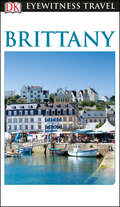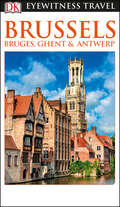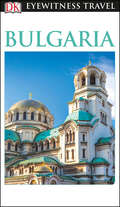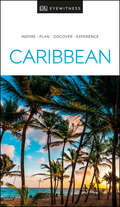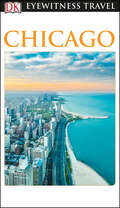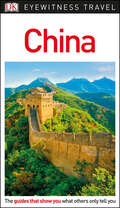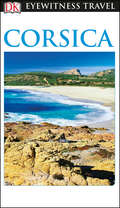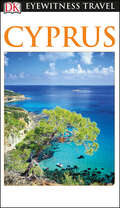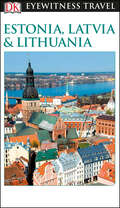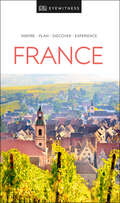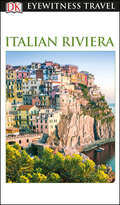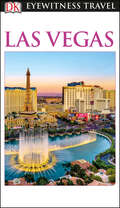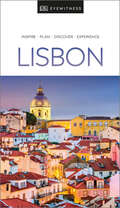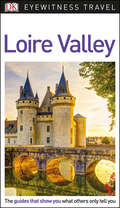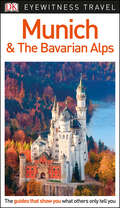- Table View
- List View
DK Eyewitness Top 10 Valencia (Pocket Travel Guide)
by DK EyewitnessThe UK&’s best-selling pocket guides – an unbeatable guide to Valencia, packed with insider tips and ideas, color maps, top 10 lists, and a laminated pull-out map, all designed to help you see the very best of Valencia.Discover Spain&’s third city – enjoy the bustle and colour of the Mercado Central, marvel at the architectural splendour of the Catedral, explore the extraordinary Ciudad de las Artes y las Ciencias, wander through the picturesque alleys of Barrio del Carmen, tuck into delicious paella, join in the festivities of Las Fallas, or simply relax on the beach.From Top 10 tapas bars to the Top 10 things to do for free – discover the best of Valencia with this easy-to-use travel guide, perfect for a short break. DK Eyewitness Top 10 Valencia is your ticket to the trip of a lifetime. Inside DK Eyewitness Top 10 Valencia you will find: - Eight easy-to-follow itineraries so you can see all the best sights, whether you&’re staying for a day, a weekend, or a week- Top 10 lists showcase the best attractions in Valencia, including Ciudad de las Artes y las Ciencias, Barrio del Carmen, La Catedral, La Lonja, Mercado Central, Jardines del Turia, Museo de Bellas Artes, L'Albufera, Xàtiva and more- Sturdy, laminated pull-out map of Valencia, plus six full-color area maps- In-depth area guides explore Valencia&’s most interesting neighbourhoods, with the best places for shopping, going out and sightseeing- Color-coded chapters divided by area make it easy to find information quickly and plan your day- Essential travel tips including our expert choices of where to stay, eat, shop and sightsee, plus useful transport, visa and health information- Color maps help you navigate with ease- Chapters cover Barrio del Carmen, the Centro Histórico, the Old Town and around, the Waterfront, and moreTouring the country? Don&’t forget to check out DK Eyewitness Spain. About DK Eyewitness: At DK Eyewitness, we believe in the power of discovery. We make it easy for you to explore your dream destinations. DK Eyewitness travel guides have been helping travellers to make the most of their breaks since 1993. Filled with expert advice, striking photography and detailed illustrations, our highly visual DK Eyewitness guides will get you closer to your next adventure. We publish guides to more than 200 destinations, from pocket-sized city guides to comprehensive country guides. Named Top Guidebook Series at the 2020 Wanderlust Reader Travel Awards, we know that wherever you go next, your DK Eyewitness travel guides are the perfect companion.
DK Eyewitness Top 10 Valencia (Pocket Travel Guide)
by DK EyewitnessThe UK&’s best-selling pocket guides – an unbeatable guide to Valencia, packed with insider tips and ideas, color maps, top 10 lists, and a laminated pull-out map, all designed to help you see the very best of Valencia.Discover Spain&’s third city – enjoy the bustle and colour of the Mercado Central, marvel at the architectural splendour of the Catedral, explore the extraordinary Ciudad de las Artes y las Ciencias, wander through the picturesque alleys of Barrio del Carmen, tuck into delicious paella, join in the festivities of Las Fallas, or simply relax on the beach.From Top 10 tapas bars to the Top 10 things to do for free – discover the best of Valencia with this easy-to-use travel guide, perfect for a short break. DK Eyewitness Top 10 Valencia is your ticket to the trip of a lifetime. Inside DK Eyewitness Top 10 Valencia you will find: - Eight easy-to-follow itineraries so you can see all the best sights, whether you&’re staying for a day, a weekend, or a week- Top 10 lists showcase the best attractions in Valencia, including Ciudad de las Artes y las Ciencias, Barrio del Carmen, La Catedral, La Lonja, Mercado Central, Jardines del Turia, Museo de Bellas Artes, L'Albufera, Xàtiva and more- Sturdy, laminated pull-out map of Valencia, plus six full-color area maps- In-depth area guides explore Valencia&’s most interesting neighbourhoods, with the best places for shopping, going out and sightseeing- Color-coded chapters divided by area make it easy to find information quickly and plan your day- Essential travel tips including our expert choices of where to stay, eat, shop and sightsee, plus useful transport, visa and health information- Color maps help you navigate with ease- Chapters cover Barrio del Carmen, the Centro Histórico, the Old Town and around, the Waterfront, and moreTouring the country? Don&’t forget to check out DK Eyewitness Spain. About DK Eyewitness: At DK Eyewitness, we believe in the power of discovery. We make it easy for you to explore your dream destinations. DK Eyewitness travel guides have been helping travellers to make the most of their breaks since 1993. Filled with expert advice, striking photography and detailed illustrations, our highly visual DK Eyewitness guides will get you closer to your next adventure. We publish guides to more than 200 destinations, from pocket-sized city guides to comprehensive country guides. Named Top Guidebook Series at the 2020 Wanderlust Reader Travel Awards, we know that wherever you go next, your DK Eyewitness travel guides are the perfect companion.
DK Eyewitness Top 10 Vancouver and Vancouver Island (Pocket Travel Guide)
by DK EyewitnessBeautifully situated between the ocean and picturesque mountains, Vancouver offers the cultural vibrancy of a modern metropolis, as well as opportunities to enjoy the breathtaking rugged coastline and wilderness of nearby Vancouver Island. Your DK Eyewitness Top 10 travel guide ensures you&’ll find your way around Vancouver and Vancouver Island with absolute ease.Our newly updated Top 10 travel guide breaks down the best of Vancouver and Vancouver Island into helpful lists of ten — from our own selected highlights to the best museums and galleries, places to eat, shops and festivals.You'll discover: • Seven easy-to-follow itineraries, perfect for a day-trip, a weekend, or a week • Detailed Top 10 lists of Vancouver and Vancouver Island&’s must-sees, including detailed descriptions of Stanley Park, Canada Place, the Capilano Suspension Bridge Park, the Museum of Anthropology at UBC, the Vancouver Art Gallery, Granville Island, Science World, Long Beach and Whistler • Vancouver and Vancouver Island&’s most interesting areas, with the best places for shopping, going out, and sightseeing • Inspiration for different things to enjoy during your trip – including children&’s activities and things to do for free • A laminated pull-out map of Vancouver and Vancouver Island, plus five color area maps • Streetsmart advice: get ready, get around, and stay safe • A lightweight format perfect for your pocket or bag when you&’re on the move DK Eyewitness Top 10s have been helping travelers to make the most of their breaks since 2002. Looking for more on Vancouver&’s culture, history and attractions? Try our DK Eyewitness Canada.
DK Eyewitness Top 10 Vancouver and Vancouver Island (Pocket Travel Guide)
by DK EyewitnessMake the most of your trip to Vancouver and Vancouver Island with DK Eyewitness Top 10. Planning is a breeze with our simple lists of ten, covering the region's best and ensuring you don't miss anything. The pocket-friendly format is light and easily portable, the perfect companion while out and about.With a new lightweight format, this Vancouver travel guide is perfect for your pocket or bag when you’re on the move.Inside, you'll find: - Top 10 lists of Vancouver and Vancouver Island's must-sees, including Stanley Park, Granville Island, the Royal BC Museum, and Whistler- Vancouver and Vancouver Island's most interesting areas, with the best places for sightseeing, food and drink, and shopping- Themed lists, including the best parks and gardens, beaches and bays, First Nations art, and much more- Easy-to-follow itineraries, perfect for a day trip, a weekend, or a week - A laminated pull-out map of Seattle, plus five full-color area mapsDK Eyewitness's Top 10s have been helping travelers make the most of their breaks since 2002.Take the work out of planning a short trip with the DK Eyewitness Top 10 series. It’s the ultimate travel guide packed with easy-to-read maps, tips, and tours to make your weekend trip or cultural break memorable. Looking for more on Canada's culture, history, and attractions? Try our DK Eyewitness Canada. We publish guides to more than 200 destinations worldwide, from pocket-sized city guides to detailed country guides.
DK Eyewitness Top 10 Venice (Pocket Travel Guide)
by DK EyewitnessVenice is a city like no other — swimming in history, culture and art, and famous for its array of remarkable architecture, palaces and festivals. Your DK Eyewitness Top 10 travel guide ensures you&’ll find your way around the City of Bridges with absolute ease.Our newly updated Top 10 travel guide breaks down the best of Venice into helpful lists of ten – from our own selected highlights to the best museums and galleries, places to eat, wine bars, shops and, of course, bridges. You'll discover: • Ten easy-to-follow itineraries, perfect for a day-trip, a weekend, or a week • Detailed Top 10 lists of Venice&’s must-sees, including detailed descriptions of the Basilica San Marco, the Doge&’s Palace, the Piazza San Marco, the Grand Canal, the Accademia Galleries, Santa Maria Gloriosa dei Frari, The Rialto, Torcello, Campo Santa Margherita and the Peggy Guggenheim Collection • Venice's most interesting areas, with the best places for shopping, dining, and sightseeing • Inspiration for different things to enjoy during your trip – including family activities, hidden gems off the beaten track and things to do for free • A laminated pull-out map of Venice, plus eight color neighborhood maps • Streetsmart advice: get ready, get around, and stay safe • A lightweight format perfect for your pocket or bag when you&’re on the move DK Eyewitness Top 10s have been helping travellers to make the most of their breaks since 2002. Looking for more on Venice&’s culture, history and attractions? Try our DK Eyewitness Venice and the Veneto or our DK Eyewitness Italy.
DK Eyewitness Top 10 Venice (Pocket Travel Guide)
by DK EyewitnessVenice is a city like no other — swimming in history, culture and art, and famous for its array of remarkable architecture, palaces and festivals. Your DK Eyewitness Top 10 travel guide ensures you&’ll find your way around the City of Bridges with absolute ease.Our newly updated Top 10 travel guide breaks down the best of Venice into helpful lists of ten – from our own selected highlights to the best museums and galleries, places to eat, wine bars, shops and, of course, bridges. You'll discover: • Ten easy-to-follow itineraries, perfect for a day-trip, a weekend, or a week • Detailed Top 10 lists of Venice&’s must-sees, including detailed descriptions of the Basilica San Marco, the Doge&’s Palace, the Piazza San Marco, the Grand Canal, the Accademia Galleries, Santa Maria Gloriosa dei Frari, The Rialto, Torcello, Campo Santa Margherita and the Peggy Guggenheim Collection • Venice's most interesting areas, with the best places for shopping, dining, and sightseeing • Inspiration for different things to enjoy during your trip – including family activities, hidden gems off the beaten track and things to do for free • A laminated pull-out map of Venice, plus eight color neighborhood maps • Streetsmart advice: get ready, get around, and stay safe • A lightweight format perfect for your pocket or bag when you&’re on the move DK Eyewitness Top 10s have been helping travellers to make the most of their breaks since 2002. Looking for more on Venice&’s culture, history and attractions? Try our DK Eyewitness Venice and the Veneto or our DK Eyewitness Italy.
DK Eyewitness Top 10 Vienna (Pocket Travel Guide)
by DK EyewitnessA city that emanates elegance, Vienna wows with its monumental palaces, grand boulevards, shimmering ballrooms and decadent café culture.Make the most of your trip to this beautiful city with DK Eyewitness Top 10. Planning is a breeze with our simple lists of ten, covering the very best that Vienna has to offer and ensuring that you don&’t miss a thing. Best of all, the pocket-friendly format is light and easily portable; the perfect companion while out and about. DK Eyewitness Top 10 Vienna is your ticket to the trip of a lifetime. Inside DK Eyewitness Top 10 Vienna you will find: - Top 10 lists of Vienna&’s must-sees, including Stephansdom, the Hofburg, the Belvedere and Hundertwasserhaus- Vienna's most interesting areas, with the best places for sightseeing, food and drink and shopping- Themed lists, including the best art galleries, music venues, Viennese dishes, things to do for free and much more- Easy-to-follow itineraries, perfect for a day trip, a weekend or a week- A laminated pull-out map of Vienna, plus six full-color area mapsLooking for more on Vienna&’s history, culture and attractions? Try our DK Eyewitness Vienna or DK Eyewitness Austria.About DK Eyewitness: At DK Eyewitness, we believe in the power of discovery. We make it easy for you to explore your dream destinations. DK Eyewitness travel guides have been helping travelers to make the most of their breaks since 1993. DK Eyewitness travel guides have been helping travelers to make the most of their breaks since 1993. Filled with expert advice, striking photography and detailed illustrations, our highly visual DK Eyewitness guides will get you closer to your next adventure. We publish guides to more than 200 destinations, from pocket-sized city guides to comprehensive country guides. Named Top Guidebook Series at the 2020 Wanderlust Reader Travel Awards, we know that wherever you go next, your DK Eyewitness travel guides are the perfect companion.
DK Eyewitness Top 10 Washington DC (Pocket Travel Guide)
by DK EyewitnessThe world&’s bestselling pocket guidesWhile it might be best known as the center of US political life, there's more to Washington, DC than the corridors of power – think historic monuments and compelling museums, lively neighborhoods and pretty parks.Make the most of your trip to America's iconic capital with DK Eyewitness Top 10. Planning is a breeze with our simple lists of ten, covering the very best that Washington, DC has to offer and ensuring that you don&’t miss a thing. Best of all, the pocket-friendly format is light and easily portable; the perfect companion while out and about.Inside you&’ll find: Up-to-date information following the COVID-19 outbreak, insider tips and advice for staying safeTop 10 lists of Washington, DC&’s must-sees, including the White House, United States Capitol, National Museum of African American History and Culture, and the National Gallery of ArtWashington, DC&’s most interesting areas, with the best places for sightseeing, food and drink, and shoppingThemed lists, including the best historic homes and buildings, museums, green spaces, places of African American history, and much moreEasy-to-follow itineraries, perfect for a day trip, a weekend, or a weekA laminated pull-out map of Washington, DC, plus six full-color area mapsDK Eyewitness Top 10s have been helping travelers to make the most of their breaks since 2002.Looking for more on Washington, DC&’s culture, history and attractions? Try our DK Eyewitness Washington, DC.
DK Eyewitness Travel Guide Brittany (Travel Guide)
by DK EyewitnessDK Eyewitness Travel Guides: the most maps, photography, and illustrations of any guide. DK Eyewitness Travel Guide: Brittany is your in-depth guide to the very best of Brittany. Enjoy all the beauty of Brittany with our DK Eyewitness Travel Guide, your secret weapon for discovering everything this gorgeous French region has to offer. From local festivals and markets to day trips around the countryside, you'll find tips and insider travel plans packed into this guide. Find the best hotels for every budget, day trips and walking tours, and the best places to eat and drink in Brittany. Discover DK Eyewitness Travel Guide: Brittany Detailed itineraries and "don't miss" destination highlights at a glance. Illustrated cutaway 3-D drawings of important sights. Floor plans and guided visitor information for major museums. Guided walking tours, local drink and dining specialties to try, things to do, and places to eat, drink, and shop by area. Area maps marked with sights. Insights into history and culture to help you understand the stories behind the sights. Hotel and restaurant listings highlight DK Choice special recommendations. With hundreds of full-color photographs, hand-drawn illustrations, and custom maps that illuminate every page, DK Eyewitness Travel Guide: Brittany truly shows you Brittany as no one else can. Recommended: For an in-depth guidebook to France, check out DK Eyewitness Travel Guide: France, which offers the most complete coverage of France, trip-planning itineraries, and more.
DK Eyewitness Travel Guide Brussels, Bruges, Ghent and Antwerp (Travel Guide)
by DK EyewitnessDK Eyewitness Travel Guide: Brussels, Bruges, Ghent and Antwerp is your indispensable guide to this beautiful part of the world. The fully updated guide includes unique cutaways, floor plans and reconstructions of the must-see sites, plus street-by-street maps of the major cities. The new-look guide is also packed with photographs and illustrations leading you straight to the best attractions. The uniquely visual DK Eyewitness Travel Guide will help you to discover everything city-to-city, from local festivals and markets to day trips around the countryside. Detailed listings will guide you to the best hotels, restaurants, bars, and shops for all budgets, while detailed practical information will help you to get around, whether by train, bus, or car. Plus, DK's excellent insider tips and essential local information will help you explore every corner of Brussels, Bruges, Ghent and Antwerp effortlessly. With hundreds of full-color photographs, hand-drawn illustrations, and custom maps that brighten every page, DK Eyewitness Travel Guide: Brussels, Bruges, Ghent and Antwerp truly shows you this region as no one else can.
DK Eyewitness Travel Guide Bulgaria (Travel Guide)
by DK EyewitnessThe lavishly illustrated DK Eyewitness Travel Guide: Bulgaria is all you need to visit this surprisingly undiscovered country rich in natural resources, history and culture. Soak up the many flavors of Bulgaria region by region, from Bulgaria's capital, Sofia, to the ancient countryside villages of Koprivshtitsa and Veliko Turnovo. Sights, beaches, markets and festivals are listed town by town. DK Eyewitness Travel Guide: Bulgaria includes 3-D cutaway illustrations, floor plans, and reconstructions of must-see sights, plus full-color city maps enable you to explore the capital and regions in depth. Walks, scenic routes, and thematic tours show you how to make the most of the country's spectacular mountain ranges and dramatic Black Sea coastline. Special features explain the history, cultural heritage, traditional festivals and local cuisine to ensure you won't miss a thing. With hundreds of full-color photographs, hand-drawn illustrations and custom maps that brighten every page, DK Eyewitness Travel Guide: Bulgaria shows you this country as no one else can.
DK Eyewitness Travel Guide Caribbean (Travel Guide)
by DK EyewitnessEscape to islands infused with vivacious culture.Whether you want to join the world's biggest street party in Trinidad, cruise around the Virgin Islands or admire Havana's yesteryear architecture, your DK Eyewitness travel guide makes sure you experience all that the Caribbean has to offer.The Caribbean conjures up images of white-sand beaches shaded by palms and lapped by crystal seas. But these immensely varied islands offer so much more - from rainforest hikes to colonial-era sights, creole flavours to reggae rhythms.Our regularly updated guide brings the Caribbean to life, transporting you there like no other travel guide does with expert-led insights and advice, detailed information on all the must-see sights, inspiring photography, and our trademark illustrations.You'll discover: - our pick of the Caribbean's must-sees, top experiences, and hidden gems- the best spots to eat, drink, shop and stay - detailed maps and walks which make navigating the region easy- easy-to-follow itineraries- expert advice: get ready, get around, and stay safe- color-coded chapters to every part of the Caribbean, from Cuba to the Cayman Islands, Jamaica to Barbados- our new lightweight format, so you can take it with you wherever you goJust visiting Cuba? Try our DK Eyewitness Cuba.
DK Eyewitness Travel Guide Chicago (Travel Guide)
by DK EyewitnessDK Eyewitness Travel Guide: Chicago will lead you through the best attractions the city has to offer, including fully illustrated coverage of all the major sights from Lincoln Park Zoo to the Art Institute of Chicago. The fully updated guide includes unique illustrated cutaways, floor plans, and reconstructions of the city's architecture, plus a pull-out city map clearly marked with attractions from the guidebook and an easy-to-use street index. DK Eyewitness Travel Guide: Chicago provides all the insider tips you need, whether you're shopping on Michigan Avenue, enjoying the rides at the Navy Pier funfair, taking in the view from the Sears Tower, or exploring the areas outside the city. Detailed listings will guide you to hotels, restaurants, bars, nightlife, and shopping for all budgets. Street maps to guide you through the city, with reliable information on getting around. With hundreds of full-color photographs, hand-drawn illustrations, and custom maps that brighten every page, DK Eyewitness Travel Guide: Chicago truly shows you this city as no one else can.
DK Eyewitness Travel Guide China (Travel Guide)
by DK EyewitnessDK Eyewitness Travel Guide: China reveals the magnificence of China's greatest sights, including in-depth coverage of the Forbidden City and Terracotta Soldiers. The guide provides expert tips for visiting the Great Wall, cruising through the stunning Yangzi Three Gorges, and exploring the ultra-modern cities of Shanghai and Hong Kong. Explore China's cultural heritage through richly illustrated features on everything from the Beijing Opera to Confucianism, calligraphy, and the cult of Mao. DK Eyewitness Travel Guide: China includes 3-D cutaway illustrations, floor plans, and reconstructions of the major architectural sights, plus maps of the key cities and towns. The best places to stay and eat have been provided by resident experts and recommendations on regional specialties will ensure you don't miss China's best dishes. Markets and festivals are listed town by town. With hundreds of full-color photographs, hand-drawn illustrations, and custom maps that brighten every page, DK Eyewitness Travel Guide: China shows you this diverse country as no one else can.
DK Eyewitness Travel Guide Corsica (Travel Guide)
by DK EyewitnessDK Eyewitness Travel Guide: Corsica helps you get the most from your visit to this unique European island. This fully updated guidebook comes packed with photographs, 3-D cutaway illustrations, and floor plans for major sights, plus advice on discovering wildlife, exploring Corsica's beaches, ports, mountains, and diving. DK Eyewitness Travel Guide: Corsica includes 3-D cutaway illustrations and floor plans of must-see sights, street-by-street maps of major towns, and reliable information on getting around this island. This guide features tips on tours, walks and scenic routes, markets and festivals, and listings for hotels, restaurants, and bars for all budgets. With hundreds of photographs, illustrations, and maps, DK Eyewitness Travel Guide: Corsica shows you what others only tell you.
DK Eyewitness Travel Guide Cyprus (Travel Guide)
by DK EyewitnessDK Eyewitness Travel Guide: Cyprus will lead you straight to the best attractions this island nation has to offer. Explore ancient sites, monasteries and hill villages, dramatic countryside, and beaches. Play in the water sports and take scenic walks. This fully updated guidebook covers of all the major sights and activities, from Nicosia to the harbor at Kyrenia. DK Eyewitness Travel Guide: Cyprus includes 3-D illustrated cutaways and floor plans of the must-see sights, including the monastery of Kykkos and the ancient town of Kourion, as well as maps and reliable information about getting around. Plus, this guidebook is packed with comprehensive listings of the best hotels, restaurants, shops, and nightlife for all budgets. With hundreds of full-color photographs, hand-drawn illustrations, and custom maps that brighten every page, DK Eyewitness Travel Guide: Cyprus truly shows you this nation as no one else can.
DK Eyewitness Travel Guide Estonia, Latvia and Lithuania (Travel Guide)
by DK EyewitnessVisit and explore Estonia, Latvia, and Lithuania during your trip to the Baltic States.From top restaurants, bars, and clubs to standout scenic sites and walks, our insider tips are sure to make your trip outstanding. Whether you're looking for unique and interesting shops and markets, or seeking the best venues for music and nightlife, we have entertainment and hotel recommendations for every budget covered in our Eyewitness Travel Guide.Discover DK Eyewitness Travel Guide: Estonia, Latvia & Lithuania. Detailed itineraries and "don't-miss" destination highlights at a glance. Illustrated cutaway 3-D drawings of important sights. Floor plans and guided visitor information for major museums. Guided walking tours, local drink and dining specialties to try, things to do, and places to eat, drink, and shop by area. Area maps marked with sights. Detailed city maps include street finder indexes for easy navigation. Insights into history and culture to help you understand the stories behind the sights. Hotel and restaurant listings highlight DK Choice special recommendations.With hundreds of full-color photographs, hand-drawn illustrations, and custom maps that illuminate every page, DK Eyewitness Travel Guide: Estonia, Latvia & Lithuania truly shows you the country as no one else can.Series Overview: For more than two decades, DK Eyewitness Travel Guides have helped travelers experience the world through the history, art, architecture, and culture of their destinations. Expert travel writers and researchers provide independent editorial advice, recommendations, and reviews. With guidebooks to hundreds of places around the globe available in print and digital formats, DK Eyewitness Travel Guides show travelers how they can discover more.DK Eyewitness Travel Guides: the most maps, photographs, and illustrations of any guide. Visit TravelDK.com to learn more.
DK Eyewitness Travel Guide France (Travel Guide)
by DK EyewitnessDK Eyewitness Travel Guide: France will lead you straight to the best attractions the country has to offer. Packed with photographs, illustrations, and detailed street-by-street maps of the major cities and towns, this fully updated guidebook will help you to discover France region-by-region, from Champagne in the north to the sun-blessed corner of Provence and the Cote d'Azur. DK's insider travel tips and essential local information will help you discover more about your destinations, from the world-class architecture of the Louvre to the island-life of Corsica to the rich culture, history, art, wine, and food of this charming country. Comprehensive listings include the best hotels, chateaus, resorts, restaurants, cafes, and nightlife in each region for all budgets. What's new in DK Eyewitness Travel Guides: New itineraries based on length of stay, regional destinations, and themes. Brand-new hotel and restaurants listings including DK's Choice recommendations. Restaurant locations plotted on redrawn area maps and listed with sights. Redesigned and refreshed interiors make the guides even easier to read. With hundreds of full-color photographs, hand-drawn illustrations, and custom maps that illuminate every page, DK Eyewitness Travel Guide: France truly shows you this country as no one else can.
DK Eyewitness Travel Guide Italian Riviera (Travel Guide)
by DK EyewitnessDK Eyewitness Travel Guide: Italian Riviera uses unparalleled photography, 3-D illustrated maps, and specially commissioned cutaway illustrations of major architectural sights to help you uncover the secrets of this beautiful region. Detailed street views of all the key areas to visit give you the option to sample the nightlife, explore the best beaches and ports for top-notch entertainment and outstanding local markets, and sail around this magnificent destination on your next vacation. Detailed listings will guide you to hotels, restaurants, bars, and shops for all budgets. What's new in DK Eyewitness Travel Guides: New itineraries based on length of stay, regional destinations, and themes. Brand-new hotel and restaurants listings including DK's Choice recommendations. Restaurant locations plotted on redrawn area maps and listed with sights. Redesigned and refreshed interiors make the guides even easier to read. With hundreds of full-color photographs, hand-drawn illustrations, and custom maps that brighten every page, DK Eyewitness Travel Guide: Italian Riviera truly shows you this destination as no one else can.
DK Eyewitness Travel Guide Las Vegas (Travel Guide)
by DK EyewitnessVisit and explore Las Vegas, a.k.a. Sin City, and walk along the strip, gamble in the casinos, eat amazing food, or stop by a show in the entertainment capital of the world.From top restaurants, bars, and clubs to standout scenic sites and walks, our insider tips are sure to make your trip outstanding. Whether you're looking for unique and interesting shops and markets, or seeking the best venues for music and nightlife, we have entertainment and hotel recommendations for every budget covered in our Eyewitness Travel Guide.Discover DK Eyewitness Travel Guide: Las Vegas. Detailed itineraries and "don't-miss" destination highlights at a glance. Illustrated cutaway 3-D drawings of important sights. Floor plans and guided visitor information for major museums. Free, color pull-out map (print edition) marked with sights from the guide, a selected sight and street index, public transit information, practical information on getting around, and a chart for measuring walking distances. Guided walking tours, local drink and dining specialties to try, things to do, and places to eat, drink, and shop by area. Area maps marked with sights. Detailed city maps include street finder indexes for easy navigation. Insights into history and culture to help you understand the stories behind the sights. Hotel and restaurant listings highlight DK Choice special recommendations.With hundreds of full-color photographs, hand-drawn illustrations, and custom maps that illuminate every page, DK Eyewitness Travel Guide: Las Vegas truly shows you the city as no one else can.Recommended: For a pocket guidebook to Las Vegas, check out DK Eyewitness Travel Guide: Top 10 Las Vegas, which is packed with dozens of top 10 lists, ensuring you make the most of your time and experience the best of everything.Series Overview: For more than two decades, DK Eyewitness Travel Guides have helped travelers experience the world through the history, art, architecture, and culture of their destinations. Expert travel writers and researchers provide independent editorial advice, recommendations, and reviews. With guidebooks to hundreds of places around the globe available in print and digital formats, DK Eyewitness Travel Guides show travelers how they can discover more.DK Eyewitness Travel Guides: the most maps, photographs, and illustrations of any guide. Visit TravelDK.com to learn more.
DK Eyewitness Travel Guide Lisbon (Travel Guide)
by DK EyewitnessDiscover Europe's capital of cool Whether you want to explore the jumbled streets of Alfama, take in the fantastic views from Castelo de São Jorge, or simply sample the city's iconic custard tarts, your DK Eyewitness travel guide makes sure you experience all that Lisbon has to offer. As one of the world's oldest cities, Lisbon's historic buildings and magnificent museums resonate history and tradition. But Lisbon also has a well-deserved reputation for European cool thanks to its vibrant nightlife, contemporary galleries and cutting-edge cuisine. Our newly updated guide brings Lisbon to life, transporting you there like no other travel guide does with expert-led insights and advice, detailed information on all the must-see sights, inspiring photography and our trademark illustrations. You'll discover: - our pick of Lisbon's must-sees, top experiences, and hidden gems - the best spots to eat, drink, shop, and stay - detailed maps and walks which make navigating the city easy - easy-to-follow itineraries - expert advice: get ready, get around, and stay safe - color-coded chapters to every part of Lisbon, from Alfama to Baixa, Bairro Alto to Belém Want the best of Lisbon in your pocket? Try our DK Eyewitness Top 10 Lisbon
DK Eyewitness Travel Guide Loire Valley (Travel Guide)
by DK EyewitnessDK Eyewitness Travel Guides: the most maps, photography, and illustrations of any guide.DK Eyewitness Travel Guide: Loire Valley is your in-depth guide to the very best of the Loire Valley in France.Whether you're on the hunt for a bike ride through the valley, a visit to fortresses and cathedrals, or a relaxing afternoon shopping at local markets, our DK Eyewitness Travel Guide has everything you'll need to experience the best of the Loire Valley. Explore old world villages and storybook chateaux, try local delicacies and superb wines, or take a walking tour and experience stunning views: We have everything you'll need to make the most of a trip to the Loire Valley on any budget.Discover DK Eyewitness Travel Guide: Loire Valley • Detailed itineraries and "don't miss" destination highlights at a glance. • Illustrated cutaway 3-D drawings of important sights. • Floor plans and guided visitor information for major museums. • Guided walking tours, local drink and dining specialties to try, things to do, and places to eat, drink, and shop by area. • Area maps marked with sights. • Insights into history and culture to help you understand the stories behind the sights. • Hotel and restaurant listings highlight DK Choice special recommendations. With hundreds of full-color photographs, hand-drawn illustrations, and custom maps that illuminate every page, DK Eyewitness Travel Guide: Loire Valley truly shows you the Loire Valley as no one else can.Recommended: For an in-depth guidebook to France, check out DK Eyewitness Travel Guide: France, which offers the most complete coverage of France, trip-planning itineraries, and more.
DK Eyewitness Travel Guide Munich and the Bavarian Alps (Travel Guide)
by DK EyewitnessDK Eyewitness Travel Guide: Munich and the Bavarian Alps is your go-to guide to this beautiful region. The fully updated guide includes unique cutaways, floor plans, and reconstructions of the must-see sights, plus a pull-out city map clearly marked with attractions from the guidebook and an easy-to-use street index. DK's insider travel tips and essential local information will help you discover the best that Munich and the Bavarian Alps have to offer, including local festivals and markets. The guide also features detailed listings to hotels, restaurants, bars, and shops for all budgets, alongside practical information to help you get around by train, bus, or car. What's new in DK Eyewitness Travel Guides: New itineraries based on length of stay, regional destinations, and themes. Brand-new hotel and restaurants listings including DK's Choice recommendations. Restaurant locations plotted on redrawn area maps and listed with sights. Redesigned and refreshed interiors make the guides even easier to read. With hundreds of full-color photographs, hand-drawn illustrations, and custom maps that illuminate every page, DK Eyewitness Travel Guide: Munich and the Bavarian Alps truly shows you this destination as no one else can.
DK Eyewitness Travel Guide Myanmar (Travel Guide)
by DK EyewitnessA new first-edition DK Eyewitness Travel Guide to Asia's top travel spot. Myanmar boasts mesmerizing temples, more than a thousand miles of pristine beaches, and a welcoming culture — all just a short flight from Bangkok — and DK Eyewitness Travel Guide: Myanmar (Burma) includes everything a traveler needs to know. Suggested itineraries highlight the sights not to be missed and help travelers plan trips by length of stay, including a two-week tour through Myanmar, two days in Yangon, and three days in Mandalay. Travelers also will find Information on cruising the Ayeyarwady River, from luxury cruisers to triple-decker ferries. And, practical information covers all the needs of travelers in this still-emerging destination, including local etiquette, banking and currency, getting around the country, and more. DK Eyewitness Travel Guide: Myanmar (Burma) is organized by region, and expert travel writers explain the stories behind the sights and include overviews of the nation's history and culture, from its ancient past to the Colonial-era to the complicated political situation of today. With hundreds of full-color photographs, hand-drawn illustrations, and custom maps that illuminate every page, DK Eyewitness Travel Guide: Myanmar (Burma) truly shows this destination as no one else can.
DK Eyewitness Travel Guide Philadelphia and the Pennsylvania Dutch Country (Travel Guide)
by DK EyewitnessDK Eyewitness Travel Guide: Philadelphia & the Pennsylvania Dutch Country is your in-depth guide to the very best of Philadelphia and the Pennsylvania Dutch Country.Discover the best of Philadelphia, from the Old City (known as "America's most historic square mile") encompassing Independence Hall and the iconic Liberty Bell to the Pennsylvania Academy of the Fine Arts. Venture outside the city to the Pennsylvania Dutch Country for a horse-drawn buggy ride, tiny road-side bakeries, and a true taste of the Amish lifestyle.Discover DK Eyewitness Travel Guide: Philadelphia & the Pennsylvania Dutch Country. • Detailed itineraries and "don't-miss" destination highlights at a glance. • Illustrated cutaway 3-D drawings of important sights. • Floor plans and guided visitor information for major museums. • Free, color pull-out map (print edition) marked with sights, a selected sight and street index, public transit map, practical information on getting around, and a distance chart for measuring walking distances. • Guided walking tours, local drink and dining specialties to try, things to do, and places to eat, drink, and shop by area. • Area maps marked with sights and restaurants. • Detailed city maps include street finder index for easy navigation. • Insights into history and culture to help you understand the stories behind the sights. • Suggested day-trips and itineraries to explore beyond the city. • Hotel and restaurant listings highlight DK Choice special recommendations. With hundreds of full-color photographs, hand-drawn illustrations, and custom maps that illuminate every page, DK Eyewitness Travel Guide: Philadelphia & the Pennsylvania Dutch Country truly shows you this region as no one else can.Series Overview: For more than two decades, DK Eyewitness Travel Guides have helped travelers experience the world through the history, art, architecture, and culture of their destinations. Expert travel writers and researchers provide independent editorial advice, recommendations, and reviews. With guidebooks to hundreds of places around the globe available in print and digital formats, DK Eyewitness Travel Guides show travelers how they can discover more.DK Eyewitness Travel Guides: the most maps, photography, and illustrations of any guide.








